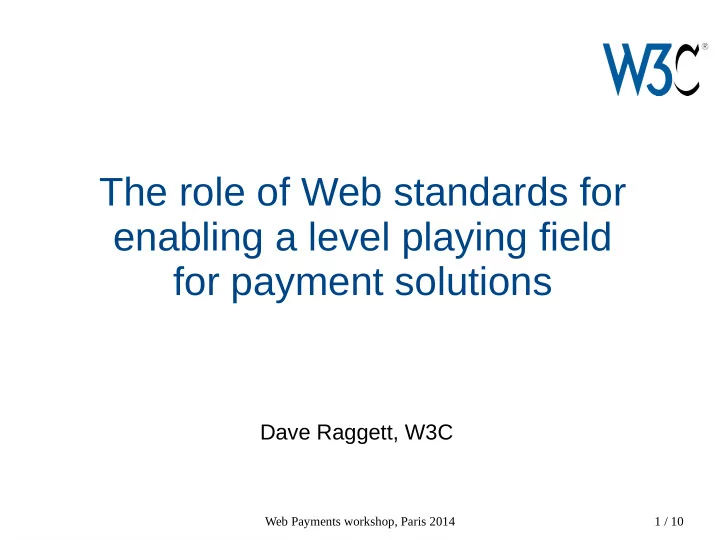

The role of Web standards for enabling a level playing field for payment solutions Dave Raggett, W3C Web Payments workshop, Paris 2014 1 / 10
Why? ● Greater freedom for users in how they can pay ● Reduced effort on behalf of merchants and developers ● Improved user experience and reduced abandonment rates though instant gratification ● Open competition as basis for easier payments, reduced overheads, and value added services ● Moving away from cash based payments – Reducing the burden on merchants to hold cash – Easier payments and receipts, e.g. taxis, restaurants ● Easier person to person payments Web Payments workshop, Paris 2014 2 / 10
Payment Front-End Process ● User clicks/taps “pay” button on web app ● Web app script invokes payment request API ● Browser routes this to the user's “wallets” ● Wallet checks which of user's payment solutions are applicable to this transaction ● User selects which payment solution she wants to use ● Wallet invokes selected payment solution ● Payment solution interacts with user as needed to authorise the payment ● Proof of purchase/Receipt passed back Web Payments workshop, Paris 2014 3 / 10
Opportunities for standardization Including Carrier billing and other approaches Wallet and payment solutions can be locally installed or based in the cloud Web Payments workshop, Paris 2014 4 / 10
Payment Request ● What information is needed from the web app? ● The amount and currency ● Description of what the payment is for as sufficient for a receipt – Human vs machine interpretable ● What payment solutions the merchant accepts – And the associated details as needed for payments ● The merchant's identity and the legal jurisdictions applicable to the transaction – Reference to contract? ● User's identity can be provided by the wallet? – Delivery address for physical goods – As needed for DRM for virtual goods ● What's needed for 3 rd party value-added services? ● What about escrow mechanisms? Web Payments workshop, Paris 2014 5 / 10
Proof of payment/Receipt ● Who needs what? – Proof of payment for merchant to proceed with delivery of the product/service – Receipts for users ● Held by wallet and available to trusted 3 rd party services – Legal requirements ● Taxation ● Disputes ● Which is better? – Proof of payment passed to web app via wallet – Or it could be delivered direct to merchant Web Payments workshop, Paris 2014 6 / 10
Improving the User Experience ● Poor User experience increases abandonment rate ● How can we reduce the effort needed from users? – Fewer steps and minimal data entry ● Commensurate with the risk model as understood by a payment solution ● Wallet shouldn't show payment solutions that can't match the merchant's requirements – e.g. don't show AMEX if merchants won't accept it ● List of names for accepted payment solutions ● Bridging the gap between users and merchants – There should be sufficient funds to cover the payment ● Users will want to see – How much funds are currently available for each payment solution – The transaction surcharge they would incur for each payment solution Web Payments workshop, Paris 2014 7 / 10
Enabling Competition ● The importance of a level playing field – Standards should be unbiased, what does this imply? – Effective competition as key to improving user experience, richer features and reduced overheads ● Open market for wallets and payment solutions – User's should be able to install and un-install these! – Standard should allow locally installed or cloud based wallets and payment solutions, right? ● We increasingly have many personal devices – Users will want consistency across devices ● A shared wallet across my devices? ● What about offline payments? Web Payments workshop, Paris 2014 8 / 10
Suite of Standards ● Payment solution providers have their own approaches to managing risk – Standards need to provide building blocks rather than forcing a one size fits all approach – New APIs for trusted web applications ● Moving away from user name and password – User authenticates to device, device to payment solution provider ● Device or trusted identity provider? – Role for secure elements and 2 nd factors ● Issue of who controls the secure element! – Revocation of credentials when device is lost, stolen, broken, discarded, or on a change of owner – Strong identity as basis for trust (privacy friendly KYC) ● Related technologies – Bluetooth beacons, NFC and barcodes Web Payments workshop, Paris 2014 9 / 10
Loyalty Schemes? ● Leather wallet stuffed full with discount coupons clipped from newspapers and junk mail ● Does this model still hold for web payments? – Merchants want to know how their customers came to know about them ● Search engine, link from another website, social or physical media, or plain old word of mouth – Encouraging repeat customers ● Save as you go schemes across a group of participating companies, e.g. UK's Nectar loyalty card ● Is there a role for the wallet to manage discount coupons and prepaid vouchers? Web Payments workshop, Paris 2014 10 / 10
Recommend
More recommend